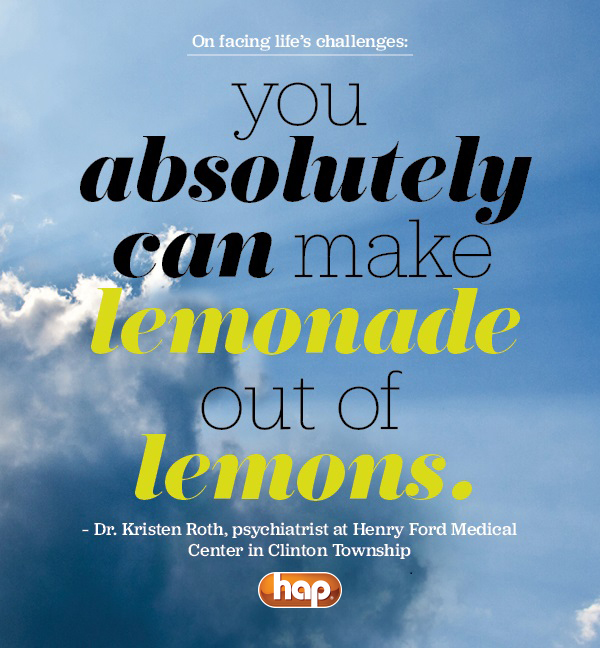
How One Doctor’s Battle With Death Gave Her a New Perspective on Life
In early 2011, Dr. Kristine Roth seemed to have it all – a beautiful 3-year-old daughter with her husband and a job she loved as a psychiatrist at Henry Ford Medical Center in Clinton Township.
But her seemingly perfect world shattered that June, when Roth, 38, was diagnosed with myelodysplastic syndrome, or MDS. MDS is a bone-marrow-related cancer most often found in older men.
Making matters worse, Roth had the type of MDS, affecting only one-third of patients, that changes to a second blood cancer, acute myeloid leukemia. The diagnosis came with little warning. Earlier, Roth had noticed some strange bruising, but a blood test in March came back normal.
Roth almost died twice from the treatments that eventually saved her. “I wouldn’t want to go through it again, but I would,” she says. “I have grown so much from it.”
When Richard Tedeschi and Lawrence Calhoun, psychology professors at the University of North Carolina in Charlotte, coined the term post-traumatic growth, or PTG, in the mid-1990s, they admitted the idea wasn’t new. The theme – facing extreme challenges can lead to positive change – is woven into centuries of cultural traditions.
But the systemic, scientific study of PTG is relatively new. It has become a vital part of positive psychology, a growing field that focuses on what makes people and communities thrive.
 Positive changes come from grappling with the aftermath of trauma, PTG researchers say. Not all people feeling trauma have such growth and even those that do suffer.
Positive changes come from grappling with the aftermath of trauma, PTG researchers say. Not all people feeling trauma have such growth and even those that do suffer.
“We most definitely are not implying that traumatic events are good – they are not,” says the website for Posttraumatic Growth Research Group. “But for many of us, life crises are inevitable, and we are not given the choice between suffering and growth.”
Roth, an M.D., warns against viewing PTG as a goal, or the result of healing “correctly.” Serious trauma, such as a spouse’s sudden death or major house fire, is uniquely awful. People react differently. Even when faced with the same life-threatening stress – a military unit in combat, for example – individual responses differ.
“Why one veteran suffers from PTSD while another doesn’t when exposed to the same traumatic event is based on myriad factors, including past experiences, brain chemistry and genetics,” Roth says. “It’s not in the person’s control.”
Roth had bad days during her illness and was, she says, “very, very depressed.” Her treatment involved a bone marrow transplant in September 2011. (One of her brothers was the donor.)
On the day of the transplant, a medication triggered a life-threatening autoimmune reaction – a cytokine storm. Roth’s body heat soared to 107 degrees Fahrenheit, her heart rate passed 200 beats per minute, and her blood pressure was undetectable. After 15 days in sterile isolation, she returned home and slowly regained strength.
But Roth’s ordeal wasn’t over. Five months later, the cancer returned. This time her doctors stopped the immunosuppressant medications that guarded Roth’s body against attacks from her brother’s stem cells.
Her doctors hoped the so-called foreigner cells would kill the cancer cells. They did, and Roth is in remission. Unfortunately, they also attacked her organs, nearly destroying her liver. Her doctors “took heroic measures” to save her, Roth says.
The second bout of cancer left her much weaker than the first. The avid snowboarder couldn’t climb a single stair. She needed a walker. “It wasn’t until early 2013 that I started to see some remote normalcy in my life,” Roth says.
In June 2015, four years after her diagnosis, Roth returned to work a better doctor. “Until you’re the patient, you try to empathize but you don’t get the full picture,” Roth says. “You realize how important the simple gestures are.”
She doesn’t regret a moment of the harrowing ordeal: the unexpected and rare diagnosis, grueling treatments and slow recovery. “I’m a better person and a fuller person,” she says. “I can offer more to the world.”
 HAP’s Restore CareTrack® program for depression and anxiety, open to all members over 18 diagnosed with depression or anxiety, offers one-on-one support. Visit hap.org for information and search for "Restore CareTrack depression." If you need help finding a counselor, contact our Coordinated Behavioral Health Management Department at (800) 444-5755.
HAP’s Restore CareTrack® program for depression and anxiety, open to all members over 18 diagnosed with depression or anxiety, offers one-on-one support. Visit hap.org for information and search for "Restore CareTrack depression." If you need help finding a counselor, contact our Coordinated Behavioral Health Management Department at (800) 444-5755.
Categories: Get Healthy
But her seemingly perfect world shattered that June, when Roth, 38, was diagnosed with myelodysplastic syndrome, or MDS. MDS is a bone-marrow-related cancer most often found in older men.
Making matters worse, Roth had the type of MDS, affecting only one-third of patients, that changes to a second blood cancer, acute myeloid leukemia. The diagnosis came with little warning. Earlier, Roth had noticed some strange bruising, but a blood test in March came back normal.
Roth almost died twice from the treatments that eventually saved her. “I wouldn’t want to go through it again, but I would,” she says. “I have grown so much from it.”
When Richard Tedeschi and Lawrence Calhoun, psychology professors at the University of North Carolina in Charlotte, coined the term post-traumatic growth, or PTG, in the mid-1990s, they admitted the idea wasn’t new. The theme – facing extreme challenges can lead to positive change – is woven into centuries of cultural traditions.
But the systemic, scientific study of PTG is relatively new. It has become a vital part of positive psychology, a growing field that focuses on what makes people and communities thrive.
 Positive changes come from grappling with the aftermath of trauma, PTG researchers say. Not all people feeling trauma have such growth and even those that do suffer.
Positive changes come from grappling with the aftermath of trauma, PTG researchers say. Not all people feeling trauma have such growth and even those that do suffer. “We most definitely are not implying that traumatic events are good – they are not,” says the website for Posttraumatic Growth Research Group. “But for many of us, life crises are inevitable, and we are not given the choice between suffering and growth.”
Roth, an M.D., warns against viewing PTG as a goal, or the result of healing “correctly.” Serious trauma, such as a spouse’s sudden death or major house fire, is uniquely awful. People react differently. Even when faced with the same life-threatening stress – a military unit in combat, for example – individual responses differ.
“Why one veteran suffers from PTSD while another doesn’t when exposed to the same traumatic event is based on myriad factors, including past experiences, brain chemistry and genetics,” Roth says. “It’s not in the person’s control.”
Roth had bad days during her illness and was, she says, “very, very depressed.” Her treatment involved a bone marrow transplant in September 2011. (One of her brothers was the donor.)
On the day of the transplant, a medication triggered a life-threatening autoimmune reaction – a cytokine storm. Roth’s body heat soared to 107 degrees Fahrenheit, her heart rate passed 200 beats per minute, and her blood pressure was undetectable. After 15 days in sterile isolation, she returned home and slowly regained strength.
But Roth’s ordeal wasn’t over. Five months later, the cancer returned. This time her doctors stopped the immunosuppressant medications that guarded Roth’s body against attacks from her brother’s stem cells.
Her doctors hoped the so-called foreigner cells would kill the cancer cells. They did, and Roth is in remission. Unfortunately, they also attacked her organs, nearly destroying her liver. Her doctors “took heroic measures” to save her, Roth says.
The second bout of cancer left her much weaker than the first. The avid snowboarder couldn’t climb a single stair. She needed a walker. “It wasn’t until early 2013 that I started to see some remote normalcy in my life,” Roth says.
In June 2015, four years after her diagnosis, Roth returned to work a better doctor. “Until you’re the patient, you try to empathize but you don’t get the full picture,” Roth says. “You realize how important the simple gestures are.”
She doesn’t regret a moment of the harrowing ordeal: the unexpected and rare diagnosis, grueling treatments and slow recovery. “I’m a better person and a fuller person,” she says. “I can offer more to the world.”
Help from HAP
Traumatic events can have lingering effects. If you have depression or anxiety for more than a week or two, contact your primary doctor. These are serious – and very treatable – medical conditions.Categories: Get Healthy
